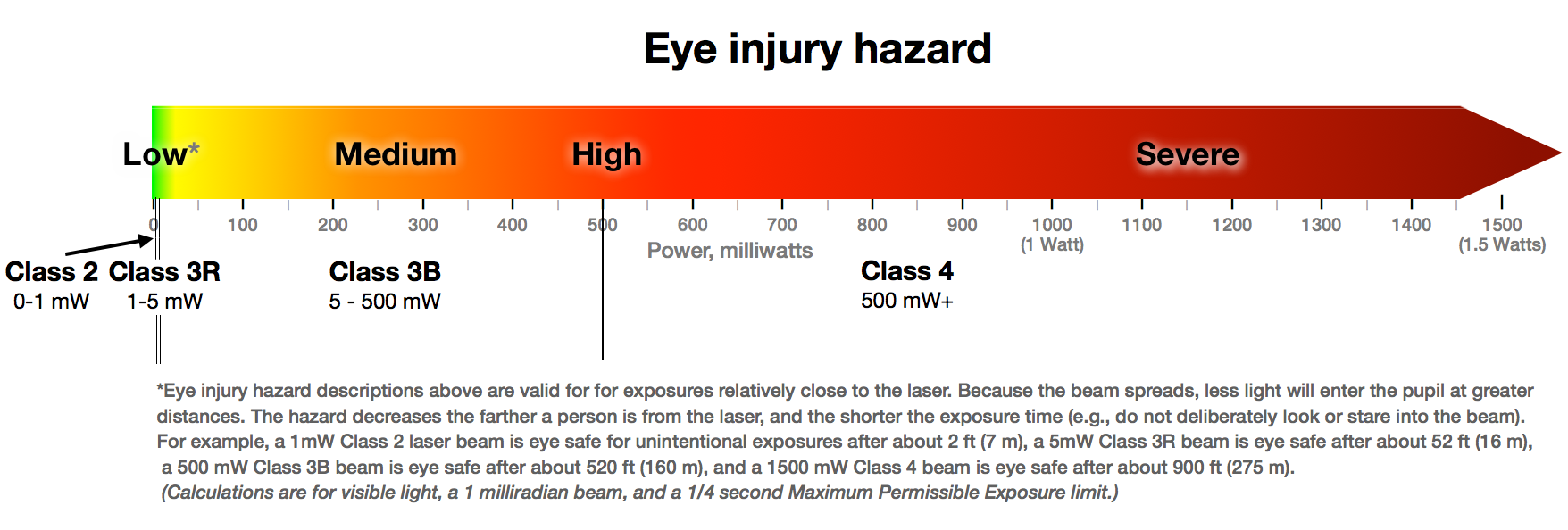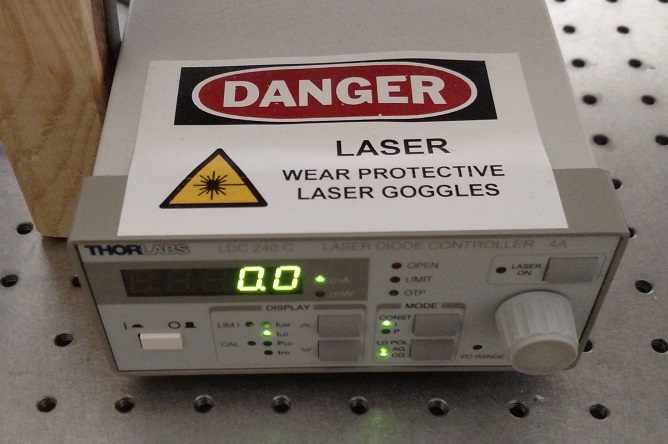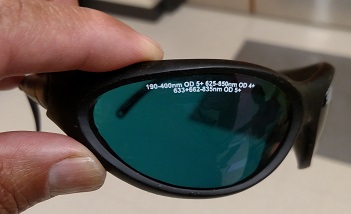
Laser Safety
Laser safety is the safe design, use and implementation of lasers to minimize the risk of laser accidents, especially those involving eye injuries. Since even relatively small amounts of laser light can lead to permanent eye injuries, the sale and usage of lasers is typically subject to government regulations.
Moderate and high-power lasers are potentially hazardous because they can burn the retina of the eye, or even the skin. To control the risk of injury, various specifications, for example 21 Code of Federal Regulations (CFR) Part 1040 in the US and IEC 60825 internationally, define "classes" of laser depending on their power and wavelength.
These regulations impose upon manufacturers required safety measures, such as labeling lasers with specific warnings, and wearing laser safety goggles when operating lasers. Consensus standards, such as American National Standards Institute (ANSI) Z136, provide users with control measures for laser hazards, as well as various tables helpful in calculating maximum permissible exposure (MPE) limits and accessible exposures limits (AELs).
Types of Beam Exposures
Exposure to the laser beam is not limited to direct beam exposure. Particularly for high powered lasers, exposure to beam reflections may be just as damaging as exposure to the primary beam.
Intrabeam exposure means that the eye or skin is exposed directly to all or part of the laser beam. The eye or skin is exposed to the full irradiance or radiant exposure possible.
Specular reflections from mirror surfaces can be nearly as harmful as exposure to the direct beam, particularly if the surface is flat. Curved mirror-like surfaces will widen the beam such that while the exposed eye or skin does not absorb the full impact of the beam, there is a larger area for possible exposure.
A diffuse surface is a surface that will reflect the laser beam in many directions. Mirror-like surfaces that are not completely flat, such as jewelry or metal tools, may cause diffuse reflections of the beam. These reflections do not carry the full power or energy of the primary beam, but may still be harmful, particularly for high powered lasers. Diffuse reflections from Class 4 lasers are capable of initiating fires.
Whether a surface is a diffuse reflector or a specular reflector will depend upon the wavelength of the beam. A surface that would be a diffuse reflector for a visible laser may be a specular reflector for an infrared laser beam.
Source: <https://ehs.oregonstate.edu/laser/training/laser-hazards>
The International Electrotechnical Commission (IEC)
Laser Classifications are summarized as follows:
Class 1: Class 1 lasers are safe under all operating conditions. There is no risk to eyes or skin. Class 1 lasers may consist of a higher power laser housed within an enclosure.
Class 1M: Class 1M lasers are not capable of producing hazardous exposure under normal operating conditions, but may be hazardous if viewed with the aid of optical instruments.
Class 2: Low power lasers (CW: up to 1mW) in visible wavelength range (400-700nm). The aversion response will protect the eye from damage due to direct exposure. There is no hazard from exposure to diffuse radiation.
Class 2M: Low power lasers (CW: up to 1mW) in visible wavelength range (400-700nm). Class 2M lasers are not hazardous under normal operating conditions because of the aversion reaction. Class 2M lasers may be hazardous if viewed with the aid of optical instruments.
Class 3R: Moderate power lasers (CW: up to 5mW) for visible wavelengths (400 to 700nm). Up to a factor of five over maximum allowable exposure of Class 2 lasers for other wavelengths. Class 3R lasers are considered low-risk but potentially hazardous.
Class 3B: Moderate power lasers (CW: up to 500mW, Pulsed up to 30mJ) in wavelength range of 300nm to far infrared. Direct eye exposure to Class 3B lasers is hazardous; however, diffusely scattered radiation is generally safe. Direct exposure to skin is a potential hazard.
Class 4: High power lasers (CW: above 500mW). Direct and diffusely scattered radiation from Class 4 lasers is hazardous to the eye. Direct exposure of Class 4 lasers are also a potential skin hazard and fire hazard.
On-the-Job Laser Reference Guide - 78 pages - Content Checklist pdf
http://www2.lbl.gov/ehs/safety/lasers/assets/docs/Laser_Reference_Guide.pdf

Eye Injury Hazard by Laser Class - pdf
Source: Laser Safety Facts
Precautions for Safe Operation of Class 3b and 4 - Medium and High Power Lasers
- Establish a controlled area for laser operation: limit access to those trained in the principles of laser safety.
- Post warning signs prominently near entrances to the laser operation area.
- Set up shields to prevent the beam from escaping the laser operation area.
- Set up a target to block the beam after it passes through the operating area.
- Keep the protective cover on the laser head during operation.
- Enclose the beam path whenever possible.
- Keep the laser beam either above or below eye level.
- Do not look at the beam directly or as reflected by a mirror or polished surface. When working with a class 4 laser, do not expose skin to beam.
- Safety glasses must be worn at all times when working with a class 4 laser.
- When working with a class 4 laser, contact your laser safety officer for operation of the laser activation warning system.
Source: <http://www.national-laser.com/laser-classification.htm>
Laser Safety Terms
Accessible Emission Limits (AEL) the maximum accessible level of laser radiation permitted within a particular laser class.
Aversion Response - Blinking of the eye, or movement of the head to avoid exposure to a bright light.
Continuous Wave (CW) - Continuous emission of radiation as opposed to short bursts.
Controlled Area - An area where the occupancy and activity of those within is subject to control and supervision for the purpose of protection from radiation hazards.
Diffuse Reflection - Change of the spatial distribution of a laser beam when it is reflected in multiple directions by a rough or matte surface.
Intrabeam Viewing - Exposing the eye to all or part of a laser beam.
Maximum Permissible Exposure (MPE) - The level of laser radiation to which a person may be exposed without hazardous effect or adverse biological changes in the eye or skin.
Nominal Hazard Zone (NHZ) - The space within which the level of the direct, reflected, or scattered radiation during normal operation exceeds the applicable MPE.
Specular Reflection - A mirror-like reflection of a laser beam.
Contact Info
Mark Musser, Chemical Hygiene Officer (CHO)920-403-4019
mark.musser@snc.edu















